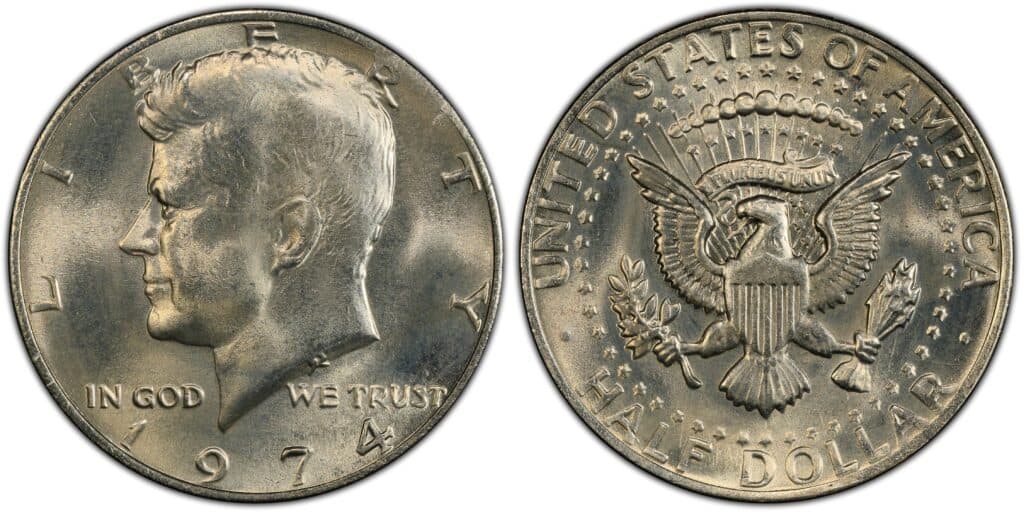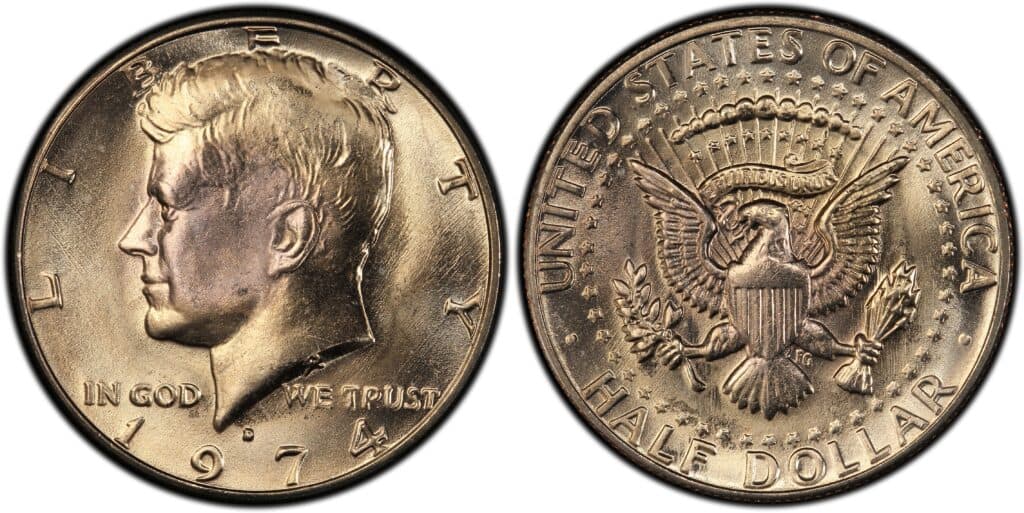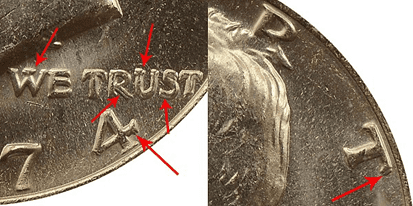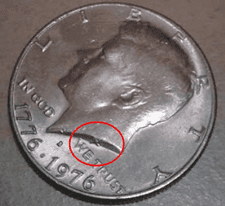What Makes A 1974 Half Dollar Rare?
The 1974 Kennedy Half Dollar is one of the more common collectable coins in circulation. Not as valuable as its silver-based predecessors, the rarest versions of this coin are the doubled die obverse miscast, and coins of a high-grade rating. Even without excessive rarity, Kennedy half dollars are popular because they depict one of the country’s most beloved presidents, John F. Kennedy.
The Kennedy Half Dollar is the only half dollar in the series to go through three metallic modifications. Starting in 1964, the Kennedy was produced from 90% silver until being reduced to 40% silver. The Kennedy Half Dollars have been produced with a copper-nickel clad alloy since 1971. This means that a 1974 Half Dollar will be made of less-value alloys and lower silver content.
How Much Does it Weigh?
The Kennedy Half Dollar is one of the more heavy coins in circulation and weighs around 11.34g (with some slight variation depending on the condition of the coin in question).
What were the milestones/events that happened when it was first released?
Lines were unending outside the US Mint facilities when the Kennedy Half Dollar was first developed, just one month after President John F. Kennedy’s assassination. The US Mint was unable to meet the demand for the new half dollar, resulting in zero being released into circulation. The fact that there were more people than coins created, over 273 million in total, demonstrates not just how much Kennedy was adored by his country.
Moving forward to 1974 when the 1974 Kennedy Half Dollar came into circulation and America was facing a time of insecurity. The aftermath of the 1973 oil crisis and the resignation of US President Richard Nixon following the Watergate scandal all occurred in this year, ironic considering the coin features the visage of one of history’s most loved presidents.
How Can You Tell If Your 1974 Half Dollar Is Silver?
As mentioned, Kennedy Half Dollars have gone through a lot of material changes over the years. Kennedy half dollars were constructed of 90 per cent silver and 10% copper in 1964.
From 1965 to 1970, half dollars were manufactured with two exterior layers of 80 per cent silver and 20 per cent copper, and an inner core of 20.9 per cent silver and 79.1 per cent copper (net composition: 40 per cent silver and 60 per cent copper).
Coins manufactured after 1971 contain an exterior coating of 75 per cent copper and 25 per cent nickel linked to a pure copper inner core. As the 1974 Kennedy half dollar was minted after 1971, this coin doesn’t have any silver content and instead is constructed of copper and nickel.
You can tell if your half dollar will contain silver by looking at the year marked on the coin.
1974 Half Dollar Series
1) 1974 Kennedy Half Dollar No Mint Mark
Year: 1974
Face Value: $0.50
Composition: 75% copper and 25% nickel
Total Weight: 11.34 grams
Diameter: 1.205 inches (30.61 millimeters)
Thickness: 0.085 in (2.16 mm)
Edge: 150 Reeds
Minted in: Philadelphia
Quantity Minted : 201,596,000 (of all types)

While you may think the lack of a mint mark could lead this coin to be valuable, this is actually one of the most common forms of the 1974 Half Dollar. Prior to 1979, coins manufactured at the Philadelphia mint lacked a mintmark with a few exceptions. Mint markings were only used on coins made at branch mints such as San Francisco, Denver, and Carson City.
2) 1974 D Kennedy Half Dollar
Year: 1974
Face Value: $0.50
Composition: 75% copper and 25% nickel
Total Weight: 11.34 grams
Diameter: 1.205 inches (30.61 millimeters)
Thickness: 0.085 in (2.16 mm)
Edge: 150 Reeds
Minted in: Denver
Quantity Minted : 201,596,000 (of all types)

Due to the conditional rarity (a condition rare is a coin whose value stems solely from its excellent condition.) of the 1974-D Kennedy, most examples in AU or lower are only worth face value. The recognized Doubled Die Obverse variation, on the other hand, demands a large premium over regular examples and can be found in near Mint condition for $40-50. If a coin is found in low Mint State condition, a collector may usually expect to pay $20-30 for it.
Coins in somewhat better condition (MS-65 and MS-66) cost between $60 and $75. They are rarely available for purchase because the highest grade documented for this type is MS-67. They usually sell for between $200 and $300 when they do.
3) 1974 S-Half Dollar
Year: 1974
Face Value: $0.50
Composition: 75% copper and 25% nickel
Total Weight: 11.34 grams
Diameter: 1.205 inches (30.61 millimeters)
Thickness: 0.085 in (2.16 mm)
Edge: 150 Reeds
Minted in: San Francisco
Quantity Minted : 201,596,000 (of all types)

The S-Half Dollars were only released as proof coins. It’s worth roughly 50 cents in average circulation (AC) condition, but one in certified mint state (MS+) condition might get up to $8 at auction. There is no conventional coin grading scale used in this price. When we say average circulated, we mean that it is in a similar condition to other 1974 coins, and mint state means that it has been certified MS+ by one of the leading coin grading firms.
4) Doubled Die obverse 1974 Kenedy Half Dollar
Year: 1974
Face Value: $0.50
Composition: 75% copper and 25% nickel
Total Weight: 11.34 grams
Diameter: 1.205 inches (30.61 millimeters)
Thickness: 0.085 in (2.16 mm)
Edge: 150 Reeds
Minted in: Denver
Quantity Minted : Unknown

A doubled die obverse (DDO) mistake appears on one of the principal varieties of the 1974 D Kennedy Half Dollar. In the motto “IN GOD WE TRUST,” the doubling is more noticeable on the right side of the coin in the phrases “WE TRUST.” The upper-right tip of the letter “T” in “LIBERTY,” as well as the right tip of the “4” in the 1974 date, have visible doubling. This type of coin can be worth around $45 (depending on the condition).
5) 1974 Half Dollar (Mark on the Neck)

You may be looking at your 1974 Kennedy Half Dollar and notice a mark on the neck and think you’re on to something rare. Sadly, this isn’t the case. So, what does the mark on Kennedy’s neck mean, and why is it there?
Kennedy’s neck stamp has nothing to do with his assassination or communist plots. It’s the elaborate monogram of Gilroy Roberts, who worked as the United States Mint’s chief engraver from 1948 to 1964. The Kennedy Half Dollar was one of the most significant works of Roberts, a renowned sculptor who died in 1992 at the age of 86.
He designed the Kennedy Half Dollar’s obverse, combining his now-famous bust of Kennedy with a reverse by Frank Gasparro that included the Presidential Seal. At the base of Kennedy’s neck, his monogram “GR” appears in elegant type.
How Much Is A 1974 Half Dollar Worth Today?
As you probably already know, the value of any coin is largely dependent on its condition which ranges from P-1 (Poor) to MS-70 (Mint State Perfect). As the 1974 Half Dollar is considered to be a conditional value coin, meaning that its value is solely linked to its condition (outside of the doubled die obverse error), there can be a broad range of what to expect when it comes to the value of your coin.
As we’ve mentioned in this article, the 1974 Half Dollar can be worth little more than its face value of 50c, all the way up to 10 or 20 bucks, with the highest value reserve for the Doubled Die Obverse coin which can be worth in excess of $45.
How Does The Grading System Work?
The Sheldon Scale is used by numismatists to provide a numerical value to coins. The Sheldon Scale goes from poor (P-1) to perfect mint state (P-1) (MS-70). Coins were originally evaluated using words to reflect their condition (Good, Fair, Excellent, Etc.). Unfortunately, coin collectors and dealers had different ideas about what each of these terms represent.
Professional numismatists joined together in the 1970s and established CoinGrading standards. These numismatists now assign grades at key places on the seventy-point scale, using the most regularly utilized numeric points in conjunction with the original adjective grade. The following are the most common coin grades:
-
-
- (P-1) Poor – Indistinguishable and probably damaged; if used, must have a date and mintmark; otherwise, rather battered.
- (FR-2) Fair – Nearly smooth, but without the damage that a coin graded Poor often possesses. The coin must have enough detail to be identified.
- (G-4) Fair – Inscriptions have merged into the rims in some areas, and important elements have been mostly erased.
- (VG-8) Very Good- A little weathered, but all of the primary design elements are visible, albeit faintly. There is little if any, central detail left.
- (F-12) Good – The item is very worn, yet the wear is even, and the overall design details stand out clearly. Rims are almost completely isolated from the field.
- (VF-20) Very Fine – Moderately weathered, with some finer features still visible. The motto or all letters of LIBERTY are readable. Both sides of the coin have entire rims that are separated from the field.
- (EF-40) Extremely Fine – Gently used; all gadgets are visible, and the most important ones are bold. The finer details are bold and clear, however, light wear may be seen.
- (AU-50) Uncirculated – Slight evidence of wear on the coin’s design’s high points; may have contact marks; eye appeal should be adequate.
- (AU-58) Uncirculated Choice – Slight traces of wear, no severe contact marks, almost full mint shine, and great eye appeal.
- (MS-60) Mint State Basal – Strictly uncirculated; no indication of wear on the coin’s highest points, but an unsightly coin with reduced luster, visible contact marks, hairlines, and other flaws.
- (MS-63) Mint State Acceptable – Uncirculated, but with contact scratches and nicks, little reduced shine, but otherwise appealing appearance. The strike is weak to average.
- (MS-65) Mint State Choice – Uncirculated with great mint shine, very little contact blemishes, and exceptional eye appeal. The strike is unusually severe.
- (MS-68) Mint State Premium Quality – Uncirculated with superb luster, no obvious contact marks to the naked eye, and exceptional eye appeal. The strike is quick and appealing.
- (MS-69) Almost Perfect Mint State – Uncirculated with perfect brilliance, a sharp and appealing strike, and extremely good eye appeal. A near-perfect coin with minor imperfections in the planchet, strike, and contact markings (seen only under 8x magnification).
- (MS-70) Mint State Perfect – Under 8x magnification, there are no tiny imperfections discernible; the strike is crisp, and the coin is perfectly centered on a beautiful planchet. Rarely seen on a coin, this coin is bright and whole, with original luster and exceptional eye appeal.
-
Where To Buy Or Sell 1974 Half Dollar?
As the 1974 Kennedy Half Dollar is a low-value coin, selling your coins at an online marketplace such as eBay. If you feel your coin might be in exceptional condition or have a unique error such as the Doubled Die Obverse variant, then you can have a coin expert assess your coin. This can be done at an auction house or through online services such as Coin Book or Rare Coins.
Just like the options above can be used for selling, they can also be used for buying too. You may even come across a 1974 half dollar in your day-to-day life, as there’s still plenty in circulation. As this is a relatively common collectable coin you could purchase an example at a flea market or antiques/collectables fair.
FAQs
Where is the mint mark on a 1974 Kennedy half dollar?
On the 1974 Kennedy Half Dollar, you’ll find the mint mark below Kennedy’s neck. Remember though, coins minted in Philadelphia will not have a mintmark.
Who is on the 1974 half dollar?
Depicted on the 1974 half dollar is former US president JFK; John F. Kennedy. Assassinated in 1963, this immensely popular president was first featured on the half dollar just one month after his untimely death.
